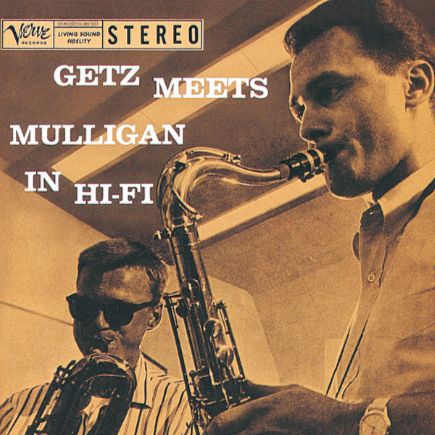I Didn’t Know What Time It Was: un standard entre Broadway et jazz moderne
Composée en 1939 par Richard Rodgers, avec des paroles de Lorenz Hart, I Didn’t Know What Time It Was voit le jour dans la comédie musicale Too Many Girls. Introduite sur scène par Richard Kollmar et Marcy Westcott, la chanson connaît rapidement un large succès grâce aux enregistrements de Benny Goodman et Artie Shaw (avec la voix d’Helen Forrest).
À la fois élégante et subtile, la composition séduit par sa structure harmonique raffinée, typique du style Rodgers & Hart, et par un texte d’une grande finesse émotionnelle. Les paroles traduisent le bouleversement amoureux avec une sensibilité introspective: l’instant où l’on perd toute notion du temps face à l’évidence d’un sentiment naissant.
I Didn’t Know What Time It Was incarne pleinement l’esprit de l’âge d’or de la comédie musicale américaine, au tournant des années 1930 et 1940, période de bouillonnement créatif où Broadway et le jazz s’enrichissent mutuellement.
Ce morceau s’est imposé comme un standard durable, revisité en swing, en ballade ou en bebop, par des chanteurs comme des instrumentistes. Sa longévité tient autant à sa richesse harmonique qu’à sa capacité à s’adapter aux styles les plus variés, traversant les décennies sans perdre sa fraîcheur.
Getz et Mulligan: conversation en haute altitude
Le 12 octobre 1957 à Los Angeles, Stan Getz et Gerry Mulligan enregistrent ensemble I Didn’t Know What Time It Was pour l’album Getz Meets Mulligan, une session qui reste dans les annales comme l’un des sommets du dialogue saxophonistique en jazz. Entourés de Lou Levy au piano, Ray Brown à la contrebasse et Stan Levey à la batterie, les deux solistes livrent une performance d’une rare complicité.
L’alchimie entre Getz, au saxophone ténor, et Mulligan, au baryton, s’impose dès les premières mesures. Leurs voix distinctes –celle, fluide et veloutée de Getz, face à la sonorité profonde et articulée de Mulligan– se croisent, se répondent et se complètent dans une interaction d’une finesse exemplaire. Loin de toute démonstration de force, leur échange repose sur l’écoute mutuelle, la respiration partagée et un sens aigu du contrepoint mélodique.
À cette époque, le jazz évolue rapidement, entre héritage du swing, affirmation du bebop et nouvelles couleurs du cool. Getz et Mulligan, tous deux associés au mouvement West coast, montrent ici qu’ils savent dépasser les catégories. Leur interprétation oscille entre lyrisme contenu et envolées rythmiques, portés par une section rythmique souple et réactive. Lou Levy distille un accompagnement aéré, Ray Brown assure une assise mobile et expressive, tandis que Stan Levey ponctue avec une élégante légèreté.
I Didn’t Know What Time It Was: un estándar entre Broadway y el jazz moderno
Compuesta en 1939 por Richard Rodgers, con letra de Lorenz Hart, I Didn’t Know What Time It Was nació en el musical Too Many Girls. Presentada en escena por Richard Kollmar y Marcy Westcott, la canción alcanzó rápidamente gran popularidad gracias a las grabaciones de Benny Goodman y Artie Shaw (con la voz de Helen Forrest).
Elegante y sutil, la pieza seduce por su estructura armónica refinada —típica del dúo Rodgers & Hart— y por un texto cargado de sensibilidad emocional. La letra expresa con delicadeza el desconcierto del enamoramiento: ese momento en que se pierde la noción del tiempo ante la evidencia de un sentimiento que emerge.
I Didn’t Know What Time It Was encarna plenamente el espíritu de la edad de oro del musical estadounidense, a finales de los años 30 y comienzos de los 40, una época de intensa creatividad donde Broadway y el jazz se enriquecían mutuamente.
Convertida en un estándar duradero, ha sido reinterpretada en versiones swing, balada o bebop, tanto por vocalistas como por instrumentistas. Su longevidad se debe tanto a su riqueza armónica como a su notable capacidad de adaptación, que le ha permitido atravesar las décadas sin perder frescura ni relevancia.
Getz y Mulligan: conversación a gran altitud
El 12 de octubre de 1957 en Los Ángeles, Stan Getz y Gerry Mulligan grabaron juntos I Didn’t Know What Time It Was para el álbum Getz Meets Mulligan, una sesión que figura entre los momentos más destacados del diálogo saxofonístico en el jazz. Acompañados por Lou Levy al piano, Ray Brown al contrabajo y Stan Levey a la batería, los dos solistas ofrecen una actuación de complicidad excepcional.
La alquimia entre Getz, al saxofón tenor, y Mulligan, al barítono, se manifiesta desde los primeros compases. Sus voces distintivas –la de Getz, fluida y aterciopelada, frente a la sonoridad profunda y articulada de Mulligan– se cruzan, se responden y se completan en una interacción de refinamiento ejemplar. Lejos de cualquier alarde, su intercambio se basa en la escucha mutua, la respiración compartida y un agudo sentido del contrapunto melódico.
En aquella época, el jazz atravesaba una transformación, entre la herencia del swing, la afirmación del bebop y los nuevos matices del cool. Getz y Mulligan, ambos asociados al movimiento de la West Coast, demuestran aquí su capacidad para trascender etiquetas. Su interpretación oscila entre lirismo contenido y estallidos rítmicos, apoyada por una sección rítmica ágil y receptiva. Lou Levy aporta un acompañamiento aireado, Ray Brown sostiene con una base flexible y expresiva, y Stan Levey acentúa con elegante ligereza.
I Didn’t Know What Time It Was: uno standard tra Broadway e jazz moderno
Composta nel 1939 da Richard Rodgers, con testo di Lorenz Hart, I Didn’t Know What Time It Was nasce all’interno del musical Too Many Girls. Presentata sul palcoscenico da Richard Kollmar e Marcy Westcott, la canzone ottiene rapidamente un grande successo grazie alle registrazioni di Benny Goodman e Artie Shaw (con la voce di Helen Forrest).
Elegante e sottile, questa composizione conquista per la sua struttura armonica raffinata — tipica dello stile Rodgers & Hart — e per il testo di grande delicatezza emotiva. Le parole esprimono con introspezione lo smarrimento dell’innamoramento: quel momento in cui si perde la cognizione del tempo davanti all’evidenza di un sentimento che nasce.
I Didn’t Know What Time It Was incarna lo spirito della golden age del musical americano, a cavallo tra gli anni ’30 e ’40, un periodo di fervore creativo in cui Broadway e il jazz si influenzavano a vicenda.
Diventato uno standard intramontabile, il brano è stato reinterpretato in chiave swing, ballad o bebop da cantanti e strumentisti. La sua longevità si deve tanto alla sua ricchezza armonica quanto alla versatilità, che gli ha permesso di attraversare epoche e stili senza perdere attualità né freschezza.
Getz e Mulligan: dialogo in alta quota
Il 12 ottobre 1957, a Los Angeles, Stan Getz e Gerry Mulligan registrano insieme I Didn’t Know What Time It Was per l’album Getz Meets Mulligan, una sessione entrata nella storia come uno dei vertici del dialogo sassofonistico nel jazz. Accompagnati da Lou Levy al pianoforte, Ray Brown al contrabbasso e Stan Levey alla batteria, i due solisti offrono un’esibizione di rara complicità.
L’alchimia tra Getz, al sax tenore, e Mulligan, al baritono, si impone fin dalle prime battute. Le loro voci –quella fluida e vellutata di Getz, di fronte alla sonorità profonda e scolpita di Mulligan– si intrecciano, si rispondono e si completano in un’interazione di grande finezza. Lungi dall’essere una sfida virtuosa, il loro scambio si fonda sull’ascolto reciproco, la respirazione comune e un marcato senso del contrappunto melodico.
Alla fine degli anni ’50, il jazz stava evolvendo rapidamente, tra l’eredità dello swing, l’affermazione del bebop e le nuove sfumature del cool jazz. Getz e Mulligan, entrambi legati alla scena della West Coast, dimostrano qui di saper andare oltre le etichette. La loro interpretazione oscilla tra lirismo misurato e slanci ritmici, sostenuti da una sezione ritmica agile e reattiva. Lou Levy offre un accompagnamento arioso, Ray Brown fornisce una base solida e flessibile, e Stan Levey punteggia il tutto con un’eleganza discreta.
I Didn’t Know What Time It Was: a standard between Broadway and modern jazz
Composed in 1939 by Richard Rodgers with lyrics by Lorenz Hart, I Didn’t Know What Time It Was was introduced in the Broadway musical Too Many Girls. Premiered on stage by Richard Kollmar and Marcy Westcott, the song quickly gained popularity through recordings by Benny Goodman and Artie Shaw (featuring vocalist Helen Forrest).
Elegant and nuanced, the piece stands out for its refined harmonic structure — characteristic of the Rodgers & Hart style — and its emotionally sensitive lyrics. The words evoke the disorientation of falling in love, capturing that moment when time seems to vanish in the presence of a newfound feeling.
I Didn’t Know What Time It Was perfectly embodies the spirit of the golden age of American musical theatre at the turn of the 1930s and 1940s — a time of intense creativity when Broadway and jazz were in constant dialogue.
Now a lasting standard, the piece has been revisited in swing, ballad, and bebop styles by both singers and instrumentalists. Its enduring appeal lies in both its harmonic richness and its remarkable adaptability, allowing it to travel through decades and genres without losing its freshness.
Getz and Mulligan: a high-altitude conversation
On October 12, 1957, in Los Angeles, Stan Getz and Gerry Mulligan recorded I Didn’t Know What Time It Was for the album Getz Meets Mulligan, a session widely regarded as a landmark in saxophone interplay in jazz. Joined by Lou Levy on piano, Ray Brown on bass, and Stan Levey on drums, the two soloists deliver a performance marked by rare mutual understanding.
The chemistry between Getz, on tenor saxophone, and Mulligan, on baritone, is evident from the very first notes. Their distinct voices—Getz’s smooth, velvety tone and Mulligan’s rich, resonant baritone—intertwine, respond to one another, and complement each other in a dialogue of exceptional finesse. Far from a competitive showcase, their exchange is built on attentive listening, shared phrasing, and a refined sense of melodic counterpoint.
In the late 1950s, jazz was undergoing significant shifts, balancing swing’s legacy, bebop’s rise, and the emerging cool aesthetic. Getz and Mulligan, both associated with the West Coast scene, show their ability to transcend stylistic labels. Their rendition flows between restrained lyricism and rhythmic drive, anchored by a responsive rhythm section. Lou Levy provides an airy accompaniment, Ray Brown grounds the music with flexible depth, and Stan Levey punctuates with tasteful lightness.


